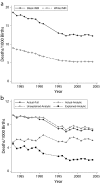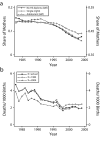The changing character of the Black-White infant mortality gap, 1983-2004
- PMID: 24354831
- PMCID: PMC4011094
- DOI: 10.2105/AJPH.2013.301349
The changing character of the Black-White infant mortality gap, 1983-2004
Abstract
Objectives: We examined how changes in demographic, geographic, and childbearing risk factors were related to changes in the Black-White infant mortality rate (IMR) gap over 2 decades.
Methods: Using 1983-2004 Vital Statistics, we applied inverse probability weighting methods to examine the relationship between risk factors and 3 outcomes: the overall IMR gap, its birth weight component, and its conditional (on birth weight) IMR component.
Results: The unexplained IMR gap (the part not related to observed risk factors) was stable, changing from 5.0 to 5.3 deaths per 1000 live births. By contrast, the explained gap declined from 4.6 to 1.9. The decline in the explained gap was driven by the changing relationship between risk factors and IMR. Further analysis revealed that most of the unexplained gap occurred among infants weighing less than 1000 grams at birth, whereas most of the explained gap occurred among infants weighing more than 1000 grams.
Conclusions: The unexplained gap was stable over the last 2 decades, but the explained gap declined markedly. If the stability of the unexplained gap continues, even complete convergence of risk factors would reduce the Black-White IMR gap by only one quarter.
Figures




References
-
- Mathews TJ, MacDorman MF. Infant mortality statistics from the 2008 period linked birth/infant death data set. Natl Vital Stat Rep. 2008;57(2):1–32. - PubMed
-
- Paneth NS. The problem of low birth weight. Future Child. 1995;5(1):19–34. - PubMed
-
- Wise PH. The anatomy of a disparity in infant mortality. Annu Rev Public Health. 2003;24(1):341–362. - PubMed
MeSH terms
LinkOut - more resources
Full Text Sources
Other Literature Sources
Miscellaneous

